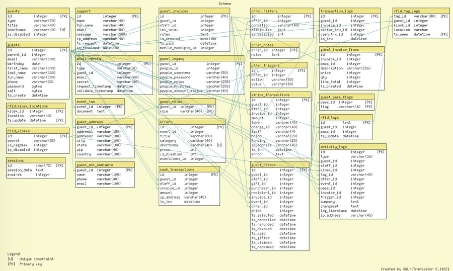Generate a Live Database Schema Diagram for your Catalyst Application
When building a web application, I always create a URL endpoint that generates a database schema diagram on the fly. This is a quick reference item that never gets old.
This approach can be used with any Perl web framework. The provided example is for the Catalyst Framework using a DBIx::Class ORM. This example provides the url http://mywebsite.com/dbdiagram
=head2 dbdiagram
Render an image representing the current data model
=cut
use SQL::Translator;
sub dbdiagram :Local :Args(0) {
my ($self, $c) = @_;
my $translator = SQL::Translator->new(
parser => 'SQL::Translator::Parser::DBIx::Class',
data => $c->model('Ezn')->schema,
producer => 'Diagram',
producer_args => {
output_type => 'png',
title => "My clever database diagram",
add_color => 1,
font_size => 'large',
},
) or die SQL::Translator->error;
$c->res->content_type('image/png');
$c->res->body($translator->translate);
}
Don't Forget to restrict to authorized users!
See also:



Top comments (6)
Oh wow, this is perfect! I recently started a job in which a primary role is maintaining and extending a rather large Catalyst app and I have never used Catalyst before. I'm also about ten years out-of-date on my Perl knowledge. So, every little bit helps. :)
Congrats on the new job, thanks for letting me know this was helpful.
A production system should not have this endpoint at all. This is bad as a security practice and means that your automation as failed or does not exist at all.
Please if you really need it just expose it from the command line.
NOTE: having ssh access to a production system also means failure in you automation pipeline.
You raise a good point: this feature is obviously to support development, not for production
What's
:Localand:Args(0)?These function attributes are particular to the Catalyst MVC Framework.
You would include this function in a Catalyst::Controller package. In this case, you may choose
YourApp::Controller::Debugas the controller name.Catalyst will map this dbdiagram action to an application URL, as specified by these function attributes.
With
:Local, this action URL part will be the function name, relative to the controller name.http://yourapp/debug/dbdiagramA Catalyst action can receive function arguments as parts of the request URL.
:Args(0)specifies this action will receive 0 arguments this way. This makes Pretty URL's easy. dbdiagram might accept a database name, and table name as arguments. This action would respond to the URL:http://yourapp/debug/dbdiagram/database_name/table_name.